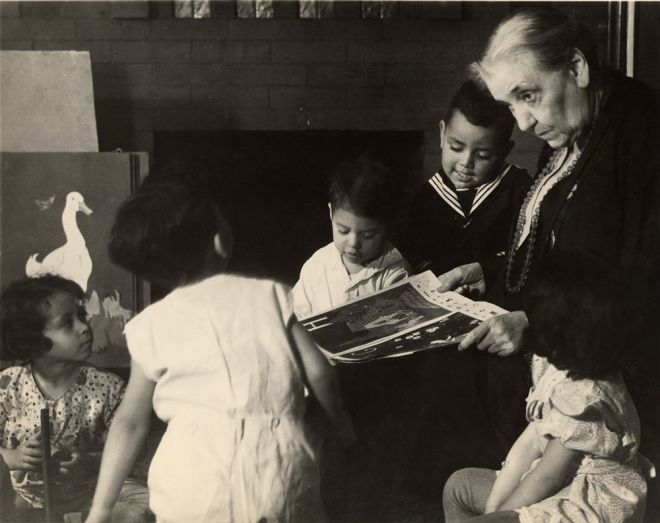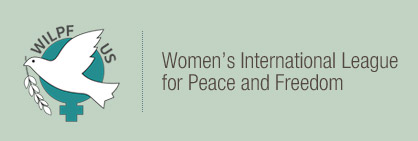Webinar Thursday, February 18: Jane Addams, Two Chicagos, and the U.S. Rich-Poor Divide Today
Published on February, 22 2021
Jane Addams with children at Hull-House. Photo courtesy of the Swarthmore Peace Collection.
By Darien De Lu
WILPF US President, with Gloria McMillan
February 2021
Many of us are aware of the "global" Jane Addams, but what do we know of the "local" Addams, who lived in the two worlds of Chicago at the turn of the 19th-20th century? And why do Addams’s two Chicagos matter to us today? Join in our WILPF webinar on Thursday, February 18 at 5:30 PST / 8:30 EST to discover wide-ranging and still relevant answers. (Registration is required for this 2/18 Zoom webinar.) The webinar features author and researcher Gloria McMillan, who wrote the Addams piece in our brand new virtual Winter/Spring 2021 issue of Peace and Freedom and Mattius Rischard of the social, cultural, and critical theory program at the University of Arizona
The global Addams joined with other feminists in 1914 to organize a peace meeting that established the 40,000-strong Woman’s Peace Party in the U.S. This national and international Addams is the one who, with other brave women, risked German submarine attacks to travel to Europe for the founding Congress of the organization that would become WILPF. She later won the Nobel Peace Prize.
The local Addams remains crucial to today’s divided cities and rural areas, and McMillan will highlight her. Addams took radical action in 1890s Chicago, where poor immigrants and, later, people of color were redlined by the housing industry. These poor Chicagoans were mostly hidden from the public eye – except when they were reviled by the press and the affluent citizenry in ways that will sound familiar to us today. Myths and fear of "the others" were everywhere in 1890s Chicago.
How did this lesser-known Addams see through the smoke and mirrors to discover the humanity of the other Chicago, that world almost fully separate from the affluent Chicago where she grew up and lived? Jane Addams openly discussed and mapped how Chicago operated on drastic urban inequality. Almost alone among 1880s U.S. reformers, she and Ellen Gates Star crossed invisible urban borders to learn by experience "how the other half lives" (to use the expression coined by Jacob Riis). These experiences directly molded Addams into the global peacemaker we generally know.
We may have heard about Addams’s opening of Hull-House, but do we understand the revolutionary nature of the ideas and organizing that provided its foundation? Addams crossed Chicago’s social-geographical-spatial divide. Her work at Hull-House underpinned her pioneering and interconnection of many crucial ideas: women's suffrage and trade unions; humanitarian concerns of food safety, sanitation, wellness, jobs, education, the value of the arts, and caring for immigrants and all poverty stricken people; and the basics that formed modern-day sociology.
In today’s world, as in turn-of-the-century Chicago, we continue to struggle with "spatial maps" of urban spaces, with real effects upon people’s lives. Places can be rendered nearly invisible, the way the poor Chicago was off the map for the other Chicago, or – today – the way a ruined Gary, Indiana, is invisible to modern Chicago and, perhaps even more so, to the rest of the country.
In our cities, above the physical urban street grid, floats a cloud of attitudes – rankings of places; attractions and repulsions. Think of your city: The street grid itself may be rational and rectilinear, but your mental map of the city is highly subjective. In Sacramento, I’m in “midtown,” only blocks away from the area further down, “south of Broadway”; but, economically and emotionally, I’m light years distant.
The webinar on Thursday, February 18 (5:30 PST/8:30 EST) offers breadth and depth – Register now! After registering, you will receive a confirmation email containing the information needed to sign in. Besides illuminating historic and political aspects of the life and work of Jane Addams, Gloria McMillan and Mattius Rischard will help us appreciate the past and current expressions and effects of spatial, psychological, and class divides. Addams's global and grand ideas came from her gritty, everyday work in and awareness of South Chicago.
At the University of Arizona, Rischard specializes in the analysis of representations of urban space, both globally and in an American studies context. That is where his and McMillan's paths have crossed, in discussions of methods of analysis in literature and cultural studies. Together, they’ll help us see how these perspectives and issues influence today’s political and activist-artist representations of the de-industrializing Midwest, part of what are sometimes called the “flyover states” – the economic problems of which, like some other areas in the U.S., are too often ignored in national media. I’ll facilitate taking your questions after the presentations.
We hope you’ll join us!



